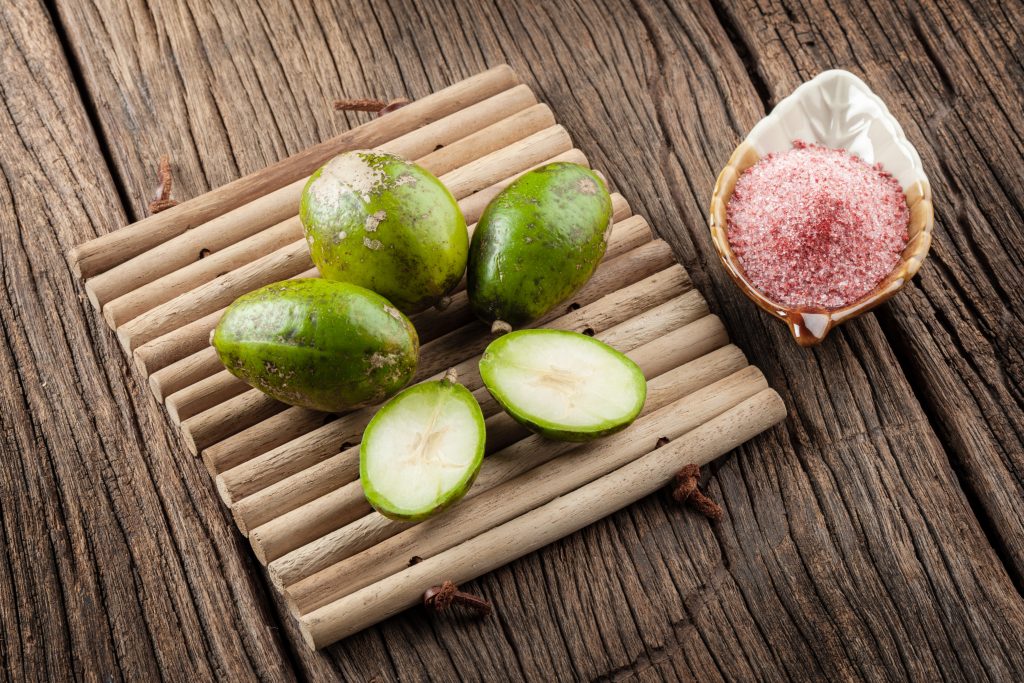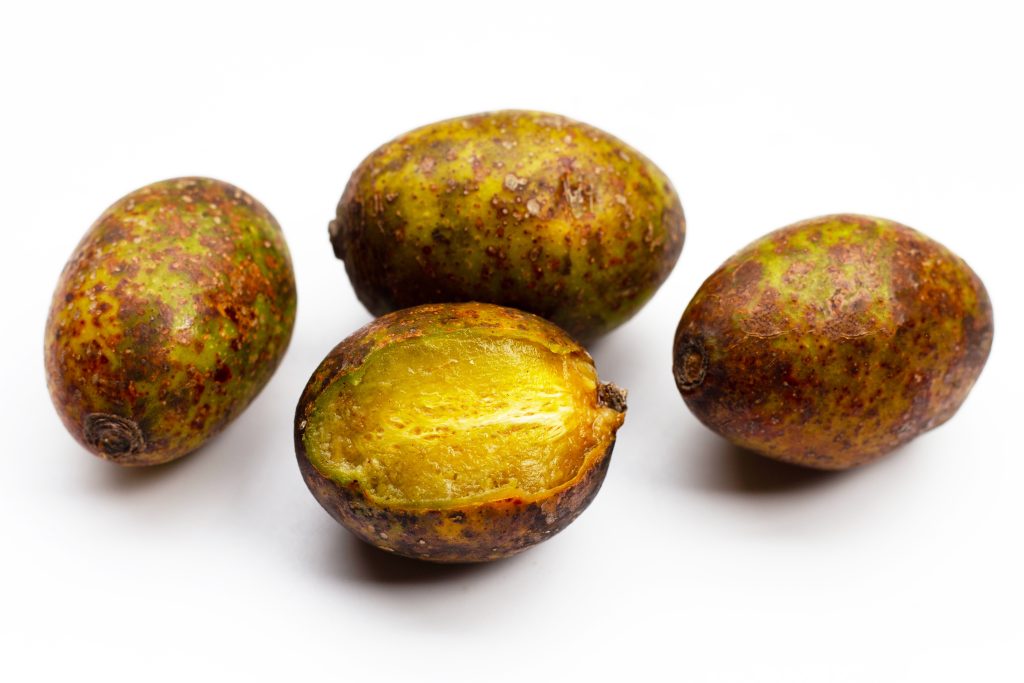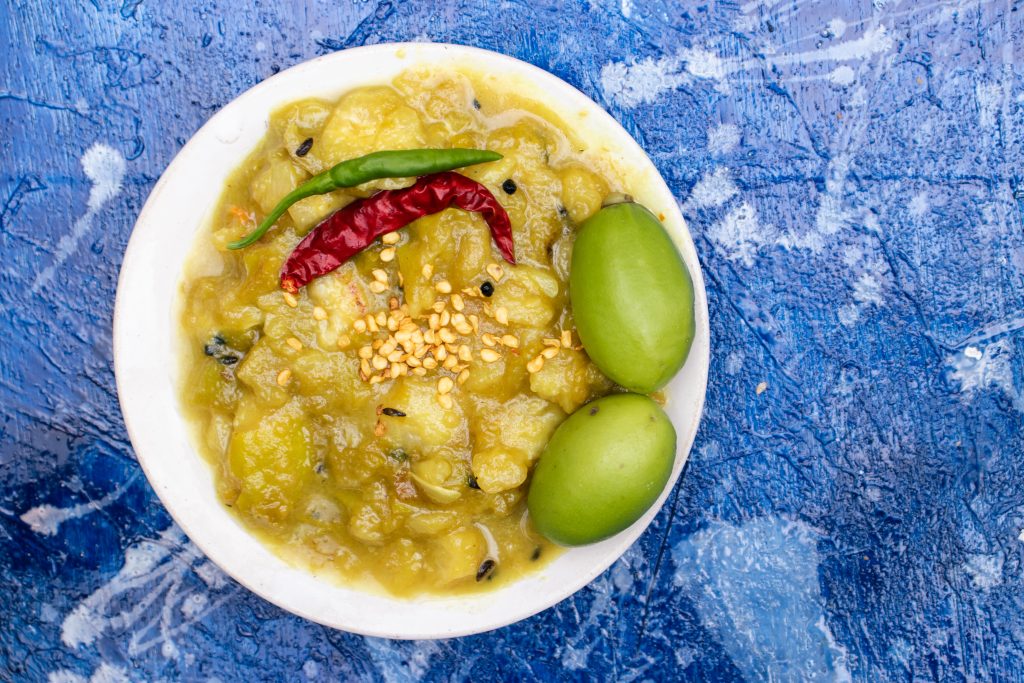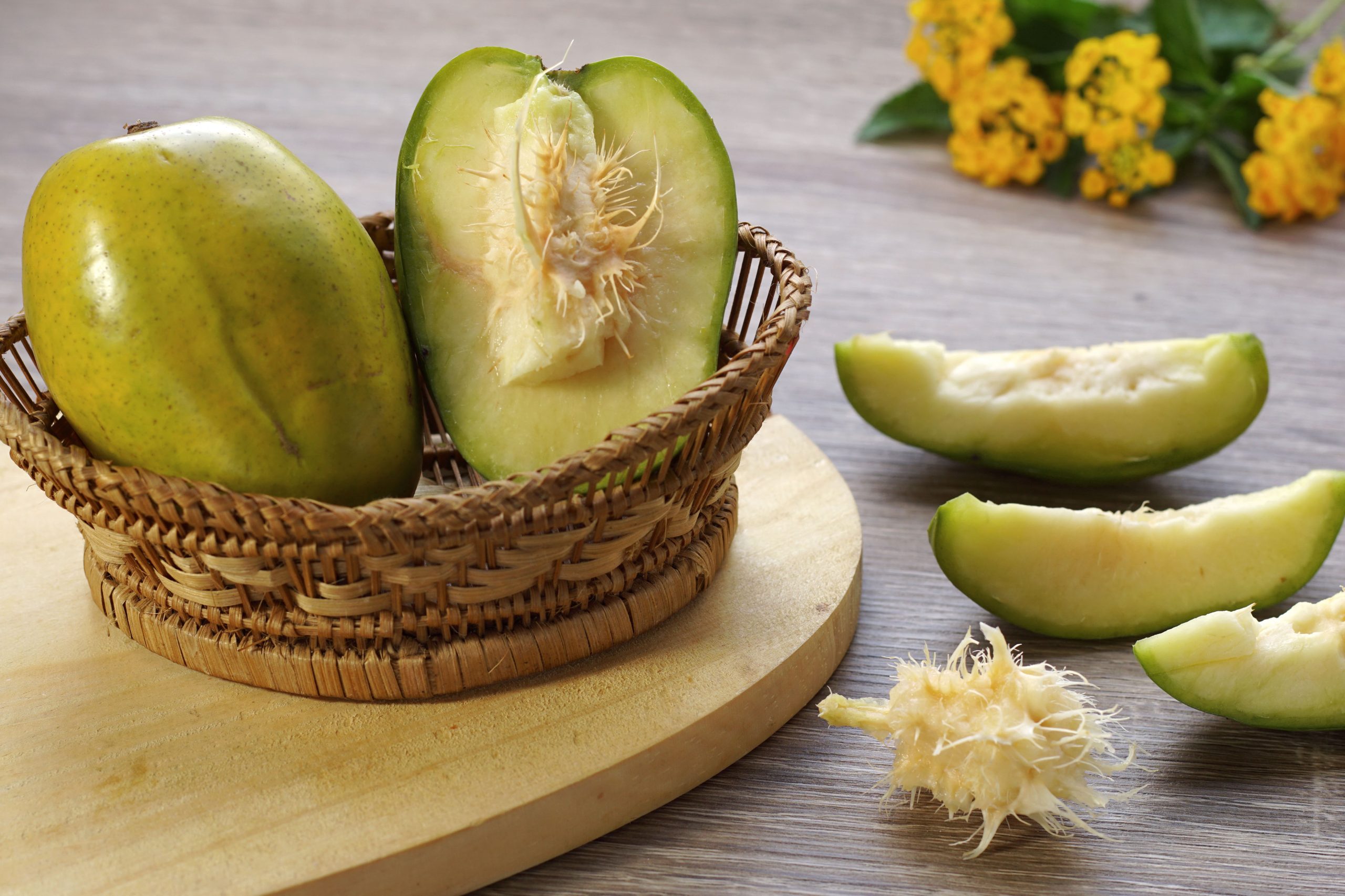Ambarella is a tropical fruit native to Polynesia and Southeast Asia. The sweet and sour flavors of the fruit make them incredibly versatile, and they are most commonly used in chutneys, pickles, and beverages.
Table of Contents
What is Ambarella?
Ambarella (Spondias dulcis), also known as “golden apple” or “June plum,” dwarf golden plum, kedondong, and Indian hog plum, is an edible fruit belonging to the Anacardiaceae family. The fruit is part of a deciduous fruit tree native to Southeast Asia, and it’s widespread in Thailand, Sri Lanka, India, and Indonesia.
The fruit is similar in appearance to a small mango or apricot. The skin is typically bright yellow; the flesh is white or pale yellow, and the fibrous pit inside contains a few seeds.
Its flesh is juicy, crunchy, tangy, and acidic, and is often used in savory dishes and condiments like chutneys. The fruit’s seed is also edible and has a nutty flavor.
The History of Ambarella
Ambarella fruits are believed to have originated in the Polynesian and Melanesian regions of the Pacific Ocean. These areas comprise many islands, such as the Solomon Islands, Papua New Guinea, Fiji, and Vanuatu.
The fruit was then introduced to Asia and subsequently made its way to Jamaica in 1782. The fruit’s popularity soon spread throughout the Caribbean and South America.
In 1909, Ambarella was introduced to Florida, United States, and it has since become naturalized in Australia.

What Does an Ambarella Taste Like?
When the fruit is ripe, it has a tangy and slightly sour taste with a crunchy texture similar to that of an unripe mango. The flesh is juicy and somewhat fibrous.
When eaten raw, the flavor of the Ambarella is refreshing and acidic. The fruit is often consumed with a sprinkle of salt or chili powder to enhance the flavor.
Ambarella can also be cooked and used in various dishes. It becomes softer and sweeter when cooked, and the tangy flavor becomes more subdued. In Sri Lanka, it is commonly used in curries and stews as a souring agent.
How to Tell When Ambarella is Ripe
Here’s how you can tell when Ambarella is ripe:
| Color | Ambarella fruit starts green and hard, but the skin and flesh turn golden as it ripens. This indicates that the fruit is ripe and ready to be picked. Green fruits are not yet ready for consumption. |
| Firmness | When the fruit is still firm (but not hard), you’ll know it’s the ideal moment to harvest it for consumption. |
| Scent | A fresh fruit has a sweet, tropical fragrance similar to a pineapple. If you notice a musky or unpleasant odor, the fruit may be overripe and past its prime. |
| Tough Fibers | If the fruit has softened too much, it may be challenging to slice due to tough fibers extending from the rough ridges of the woody core. This is a sign that the fruit is overripe and may not be suitable for consumption. |

Can I Eat Raw Ambarella?
While it is possible to eat Ambarella raw, it is essential to note that the unripe fruit can be very sour and may cause a tingling sensation in the mouth due to its high acidity.
Therefore, it is recommended only to eat fully ripe Ambarella, which is sweeter and less acidic. It is also essential to wash the fruit thoroughly before eating to remove any dirt or bacteria on the surface.
Cooking with Ambarella
Ambarella fruit preparation:
- Rinse the ambarella fruit under running water to remove any dirt or debris.
- Cut off the stem and the bottom of the fruit.
- Use a sharp knife to carefully slice off the skin, which can be tough and fibrous.
- Cut the fruit in half lengthwise and remove the seed in the middle.
- Cut the fruit into thin slices or cubes, and it’s now ready to be used in recipes.
Ambarella is a versatile fruit used in various dishes, including salads, curries, jams, jellies, chutneys, and pickles. In Southeast Asia, it is commonly used in sweet and sour dishes. It is often used in marinades, soups, and stews in the Caribbean. They’re also used in Thai dishes.

Here are some examples of dishes that use Ambarella:
Sweet & Spicy Ambarella Curry: This recipe is a great way to incorporate the bold flavor of Ambarella into your curry dishes. Theambarella adds a sweet taste, while the curry leaves and chili provides some spice.
Ambarella and Raisin Chutney: The sweetness of the raisins combines beautifully with the tanginess of Ambarella and gives it a unique flavor you’ll love! You can use this as a dip for bread or crackers or even on its own as an appetizer or snack!
Jamaican Stewed June Plum: The sweetness of June plums in this dish can be paired with hearty meats like beef for a taste that will warm you up on even the coldest winter day.
Pommecythere Chow (Pickled Ambarella): This pickled Ambarella adds a tangy flavor that goes well with both savory and sweet dishes alike!
How to Store Ambarella
Freezer: You can slice them, store them in a resealable plastic zipper bag, and place them in the freezer. This method will allow you to keep them fresh for up to 5 months.
Refrigerator: If you decide to keep them whole and unpeeled, you can place them whole in your refrigerator’s crisper, but they will only last for about two weeks before spoilage.
Nutritional Benefits of Ambarella
Ambarellas have various health benefits due to their natural antioxidants, antimicrobial agents, and cytotoxic compounds. These agents protect the body from infection, thrombosis, and harmful cells, including cancer. The leaves of the ambarella tree can also be used to treat inflammation and sore throat.
Additionally, ambarellas are rich in vitamin C, which promotes iron absorption, protects cells from damage, stimulates collagen production, and helps recovery while preventing premature aging. The vitamin A in this fruit is essential in improving vision overall.
Their high fiber content can help treat digestive problems and improve heart health. Calcium and phosphorus in ambarella fruits are essential in maintaining healthy bones and teeth.
Where to Purchase Ambarella
You may find it in specialty stores or farmers’ markets with tropical fruits. However, availability may vary depending on your location.
The best time of year to find Ambarella is typically in the summer and fall months when the fruit is in season in tropical regions. If you are in the United States, you may have better luck finding Ambarella in states with warmer climates, such as Florida, Texas, or California.
If you are unable to find fresh Ambarella in your area, you may be able to find it frozen or canned at some specialty stores or online retailers that specialize in tropical fruits. Some international grocery stores may also carry it in canned or dried form.

